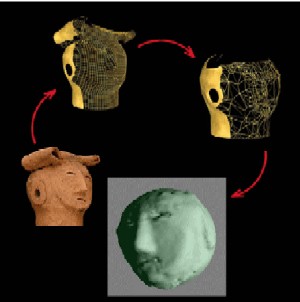Haniwa: Reconstruction Case Study

M. B. H. Shanat, P.-A. Fayolle, B. Schmitt, T. Vilbrandt
Haniwa : A Case Study of Digital Visualization of Virtual Heritage Properties,
20th Eurographics UK Conference (De Montfort University, Leicester, UK), IEEE Computer Society, 2002, pp. 24-32.
Electronic version: PDF (566K)
Abstract
Haniwa is a term for unglazed clay artifacts in Japan, which were lined up on the outer surface of mounded tombs. This work represents a practical case study of constructing a relatively accurate digital model of a Japanese haniwa from 360 degree scan data of an ancient artifact via non-contact 3D laser scanning. The goal is that this research will help the archeologist and geologist to generate artifacts in proper 3D representation and concurrently to provide an opportunity for attractive, accurate, informative and interactive 3D visualization, animation and VRML on a CD or over the Web. In our case study, we use a discrete cloud of points scattered on a surface to construct the function representation (FRep) of a 3D volume. The points have been obtained with a laser scanner. The FRep reconstruction is based on the new implementation of the algorithm using radial basis functions. The algorithm is implemented as a library function for the HyperFun modeling language.